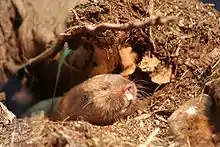Ansell's mole-rat
Ansell's mole-rat (Fukomys anselli) is a species of rodent in the family Bathyergidae. It is endemic to Zambia. Its natural habitats are moist savanna and miombo forests. It is noted for its very long tunnels, up to 2.8 km (1.7 mi) for a single colony of only ten individuals.[2] The colonies are made of an eusocial system. They include a main reproductive king and queen that are thought to be faithful to one another.[3]
| Ansell's mole-rat | |
|---|---|
 | |
| Scientific classification | |
| Domain: | Eukaryota |
| Kingdom: | Animalia |
| Phylum: | Chordata |
| Class: | Mammalia |
| Order: | Rodentia |
| Family: | Bathyergidae |
| Genus: | Fukomys |
| Species: | F. anselli |
| Binomial name | |
| Fukomys anselli (Burda, Zima, Scharff, Macholán & Kawalika, 1999) | |
| Synonyms | |
|
Cryptomys anselli | |
Ansell's mole-rats (Fukomys anselli) develop their underground habitat using their anatomical features such as body shape, chiseled teeth, and large jaws to dig through the soil. These long tunnels often branch off at various levels in the soil which allow mole-rats to create the space needed for their survival, such as searching for plants, creating food storage areas, and communicating with other nearby family groups.[4]
References
- Dando, T.; Van Daele, P. (2020). "Fukomys anselli". IUCN Red List of Threatened Species. 2020: e.T44858A22184572. doi:10.2305/IUCN.UK.2020-2.RLTS.T44858A22184572.en. Retrieved 16 November 2021.
- "Zoologger: The longest tunnels dug by a mammal".
- de Vries, J. L.; Oosthuizen, M. K.; Sichilima, A. M.; Bennett, N. C. (December 2008). "Circadian rhythms of locomotor activity in Ansell's mole-rat: are mole-rat's clocks ticking?". Journal of Zoology. 276 (4): 343–349. doi:10.1111/j.1469-7998.2008.00496.x. hdl:2263/8930.
- Begall, S.; Burda, H.; Caspar, K. R. (2021). "Fukomys anselli (Rodentia: Bathyergidae)". Mammalian Species. 53 (1012): 160–173. doi:10.1093/mspecies/seab015. ISSN 0076-3519.
- Woods, C. A. and C. W. Kilpatrick. 2005. pp 1538–1600 in Mammal Species of the World a Taxonomic and Geographic Reference 3rd ed. D. E. Wilson and D. M. Reeder eds. Smithsonian Institution Press, Washington D.C.



